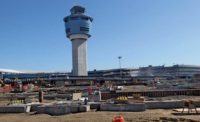Odebrecht became aware of Fudo and the MVT method from its work on Louisiana levee projects, says Mauricio Gonzalez, project executive.
Reducing noise and vibrations—a benefit of MVT over the traditional deep dynamic compaction method—was vital considering the proximity of residents, aircraft and a control tower, says Rodolfo Armenta, an Odebrecht project manager.
Crews vibrate the deeper layers of ground for 90 seconds, two times, using a 10 ft by 10 ft steel plate, says Murtha. "In between, there's a 7 ft by 7 ft plate that is vibrated for 60 seconds," he adds.
"The larger plate densifies soils at deeper elevations, and the smaller one gives us concentrated energy on the upper layers," says Armenta.
If the specified compaction isn't achieved, "we trench and then we tamp again," Gonzalez says.
Additionally, the team is preparing to address some 1,777,500 sq ft, out of a total 5.8 million sq ft, where compaction is needed for depths below 10 ft, due to more extensive pinnacle rock.
This spring crews will begin using a vibratory rod method, where a rod or H-beam attached to a motor is inserted approximately 12 ft deep at predetermined spacings, says Gonzalez.
The rod is then lifted up a few feet and the hole is partly filled with material. Then the rod goes back down, compacts that material, and the process repeats until the hole is fully backfilled, he says. All compaction work is slated for completion by the end of year. Paving crews could mobilize in July, laying the groundwork for the runway's opening next year.











Post a comment to this article
Report Abusive Comment